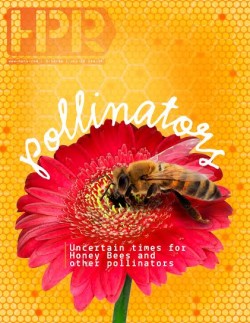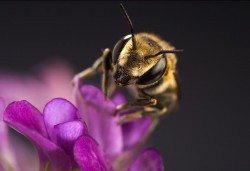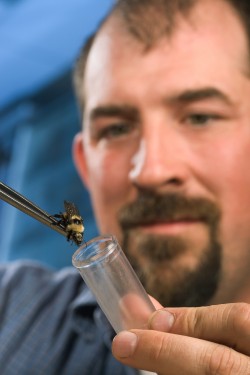News | May 11th, 2016

John Gehrke drives truck around the country, hauling lumber, steers, electronics, building materials, hay and almost anything that can ride on a flatbed trailer.
Including honeybees.
Gehrke said he started hauling bees 25 years ago and enjoyed it. He continues to transport the pollinators between California and North Dakota, about 408 to 512 hives per load.
“I think it will keep me busy until I decide to retire,” Gehrke said.
North Dakota is the nation’s top honey producing state, with 42.1 million pounds produced in 2014 from 490,000 colonies in the state. This number follows 2013’s statistic of 33.1 million pounds of honey produced in the state.
Despite this success, North Dakota’s pollinators and those nationwide face uncertain times as forage and rangeland to support colonies disappear due to aspects of agriculture, among other reasons.
Some Stats
U.S. honey production decreased 12 percent from 2014, the USDA reported. Honey producers with five or more colonies made out with 157 million pounds of honey last year, but colonies are down 3 percent from 2014.
North Dakota’s 490,000 honey producing colonies nabbed an average of 86 pounds per colony. No other state comes close to North Dakota’s colony count in the USDA’s report, aside from South Dakota at 290,000 in 2015 and California at 275,000 last year, down from 320,000 in 2014.
Pollinators range from insects, birds and bats to gravity, wind and water, as Washington State University reported in an extension agency’s video on pollinators.

In North Dakota, conservation reserve acres of the Conservation Reserve Program are key for colonies, as Andrew Thostenson, pesticide program specialist at North Dakota State, said these lands hold essential habitat.
“The federal government pays (landowners) an annual rent to keep them in grasses … and permanent cover,” he said, “That’s been a really important source of food and harborage and rangeland of the bees.”
In 2004, North Dakota had over 3.36 million acres of CRP lands, Thostenson said, but with high agriculture commodities since 2011, many farmers and landowners did not renew their CRP contracts, putting those grasslands under cultivation, much of it for corn and soybeans.
In 2014, North Dakota had just under 1.17 million acres of CRP lands.
“This just means there’s less places for these bees to naturally roam,” Thostenson said.
Moreover, the corn and soybeans planted in place of grass created a monoculture that is “not a real plentiful, good source for bees,” Thostenson said, creating “a displacement of forage.”
Lack of genetic diversity in bees is another issues, Thostenson said, as bees are less tolerable to diseases to parasites.
“They don’t have any natural resistance in their populations,” he said.
Pesticides
Other stressors have impacted the bees as well, from parasitic mites to pesticide issues potentially compounding the problem, stemming from neonicotinoids in some pesticides.
“I think the important thing to note with respect to pesticides is we haven’t had any incidents or complaints where hives have been killed outright from pesticide application, and there hasn’t (sic) been complaints about that in a good number of years,” Thostenson said.
This is due to a number of reasons he said, including North Dakota’s Department of Agriculture’s advanced mapping technology in locating hives.
The department also has a pollinator protection plan in place, a series of best management practices for beekeepers and pesticide applicators to minimize impacts from the latter on pollinators.
Thostenson, who has trained pesticide applicators for 19 years, said the last four or five years have been key in pesticide training.
“I like to think that we’ve at least tried to minimize or reduce pesticides as a problem for beekeepers, or at least a manageable issue,” he said.
Despite that, Thostenson said larger economic problems loom with the lack of forage and rangeland available for bees, and that’s not a North Dakota problem, but one other states face as well.

‘Beekeeping seems cool’
Sunny Branick keeps a colony of bees as a link to his family’s farming heritage.
“My generation is the first one off the farm, so I wanted to do something to keep in touch with that,” the Kansas native said. “Beekeeping seems cool.”
He also thought it was “ecologically useful.”
Online research was Branick’s first step, as was adjusting his hobby for the climate. Beekeeping is not the same nationwide, he said.
“Beekeeping is … more of an art than a science,” he said. “There’s a saying amongst beekeepers that if you ask any one question, you’ll get 15 different answers.”
Management practices and hive styles range from state to state, Branick said, varying from “holistic beekeeping” left to nature to commercial, chemicalized beekeeping.
“It’s all about what works for you,” Branick said, who has kept bees for a year but hasn’t harvested honey yet because he’s “playing it easy and playing it safe” to conserve honey and wax.
As for wintering bees in North Dakota, it’s not the cold, per se, that is the battle, but keeping them dry.
“Moisture is what will do the bees in or anything else because they all cluster in this tight ball to keep warm,” he said.
Most North Dakota beekeepers use special box or tarpaper to protect from wind and moisture in winter, Branick said. He also tilts his hive forward to run out condensation.
Warmth is another danger as warm bees are more active and eat more.
Nate Giroux lauds backyard beekeepers like Branick, no matter their size.
Giroux helps run Minot’s Bakers Bridge Honey, and said today isn’t like the old days.
“It’s harder to keep them alive. Everything gets more complicated,” he said, as treatments are taken off the market, pesticides and parasites pose issues and beekeepers must now winter their bees around the country.
Bakers Bridge Honey runs 5,000 hives for honey production, Giroux said, mainly all in North Dakota.
The state’s weather is a huge factor facing bees and other pollinators, as are crop diversity, rainfall and the disappearance of CRP lands.
“We’re still the number one state but there’s not a lot of CRP and alfalfa anymore,” Giroux said. “We’re getting a lot of corn and flax and soybeans.”
Giroux tips his hat to backyard beekeepers, but said it’s hard.
“You need many years in this to know what they look like, what they’re doing,” he said, adding, “But I’m happy there’re guys who want to do this.”
Time and knowledge are key to those starting in beekeeping, Giroux said.
“You gotta know what you’re doing,” he said.
Outlook

Giroux said the future is an uphill battle.
“We’re farmers just like anybody else but we kinda work on the opposite scale of normal farmers,” he said. “They need to spray to kill bugs on their crops and anything they spray kills our bees. If we could work together more, we’d have an ideal situation.”
The cultures clash, Giroux said, but communication is beneficial, as are friends in the business.
Branick is part of Beedazzled, a Facebook group of Upper Midwestern beekeepers. He sees the future as “fairly good.”
Many people are returning to the hobby, he said, following in the footsteps of past family.
Area residents can help pollinators beyond keeping hives, he added, by simply offering more than grassy lawns, which offer nothing to bees.
“I think a lot of people don’t realize that really most of this could be fixed, at least locally, if people just planted a wider variety of things than to have giant, uninterrupted lawns of grass because grass is worthless to most pollinators,” Branick said.
Angiosperms are important to have around, more so than “ecologically destructive” lawns, Branick said. Growing produce in one’s own lawn is an example of a practice for improving pollinators, he said.
Providing food for pollinators is vital to sustaining a small population of creatures that pollinate the vast majority of agricultural products, Branick added.
“(Bees) are here. You just have to put something out to invite them over,” he said, adding Fargo’s Little Free Garden movement is another way to set out a feast for pollinators.
Research programs are also addressing declining colonies and other issues facing pollinators, Thostenson said, from speaker events at NDSU to the University of Minnesota’s bee laboratory.
“The last three years in particular, they finally got some traction in terms of getting some people’s ears,” Thostenson said. “We’re certainly getting some traction in terms of some new research and development in dealing with these parasite problems.”
Breeding programs, introducing new honeybees and other research are benefitting the pollinators, research that hasn’t been done in decades, Thostenson said, compared to livestock research that continually grows.
As a small business enterprise, often nomadic and varying in states and climates, beekeeping hasn’t been part of a coherent enterprise to streamline its industry, Thostenson said.
“There are some big, large beekeeping enterprises out there, but there are so many of them that are small family operations or maybe two or three or four people involved in it … and it’s the nomadic nature of it,” Thostenson said, adding a disconnect between states in overwintering and hauling bees can be an issue too.
“The bees are constantly being moved around,” he said. “If the bees were just here in North Dakota all the time and all the bees that were hived here were just North Dakota bees … it seems more logical than expected to be able to develop more coherent industry advocacy.
“But they’re getting traction. I’m not sure that they’re over the hump, but they’re finally getting some fantastic things to happen there with respect to bees. … I’m impressed with some of the work that’s being done.”
April 18th 2024
April 18th 2024
April 18th 2024
March 21st 2024
February 15th 2024
__293px-wide.jpg)

__293px-wide.jpg)


